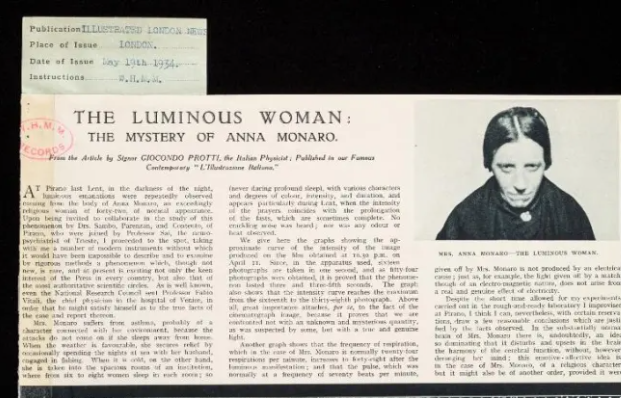
Anna Monaro’s story is one of those tales that seem to come straight out of a gothic novel or a collection of extraordinary clinical cases, yet it appears in Italian medical reports from the 1930s. The year was 1934, and an amateur cyclist from Veneto – Anna Monaro – drew the attention of the scientific community not for her athletic performance, but for a phenomenon that seemed to defy every medical explanation of the time: during sleep, she would emit a visible light, a faint luminescence emanating from her chest area.
The case came under the observation of Professor Giuseppe Calligaris, a neurologist and physician from Friuli known for his unconventional studies, on the margins of official medicine. Calligaris was interested in psychosomatic phenomena and in the interaction between mind, body, and subtle energies. When he came across the Monaro case, he interpreted it as a possible manifestation of “luminous bioemission,” an idea that in modern science finds some echoes in rare studies on biophotoluminescence.
The phenomenon was observed several times over the course of weeks: while Anna slept, witnesses reported seeing a faint greenish light, visible even in low light, radiating from her chest area. Contemporary sources report that she underwent various clinical examinations, all without significant results. No metabolic anomalies, no apparent chemical reactions on the skin, no signs of known pathologies. And yet, the light had been noted by multiple observers, including doctors.
Today, in retrospect, one might speak of ultra-weak photon emission (UPE), a real phenomenon documented in laboratories. Living cells, in fact, emit a minimal quantity of photons visible only with ultra-sensitive instruments. However, this emission is billions of times weaker than what the human eye can perceive. No one, according to current knowledge, would be able to “glow” visibly without the aid of chemicals or external technologies.
The Monaro case, however, remains shrouded in mystery. Some have hypothesized that it was an extraordinary psychosomatic manifestation, perhaps linked to altered states of consciousness during deep sleep. Others have proposed more skeptical explanations, suggesting collective hallucinations, autosuggestion, or perceptual errors due to ambient lights. But no definitive explanation has ever been given.
In the historical archives of anecdotal medicine, the name Anna Monaro remains inscribed as one of the few recorded cases of alleged spontaneous human luminescence. A story that, even today, nearly a century later, challenges the limits of what we believe possible about the human body.
~~~ embed:Thelemites/comments/1m2y289/every_man_and_woman_is_a_star_the_strange_light/ reddit metadata:fFRoZWxlbWl0ZXN8aHR0cHM6Ly93d3cucmVkZGl0LmNvbS9yL1RoZWxlbWl0ZXMvY29tbWVudHMvMW0yeTI4OS9ldmVyeV9tYW5fYW5kX3dvbWFuX2lzX2Ffc3Rhcl90aGVfc3RyYW5nZV9saWdodC98 ~~~
This post has been shared on Reddit by @davideownzall through the HivePosh initiative.